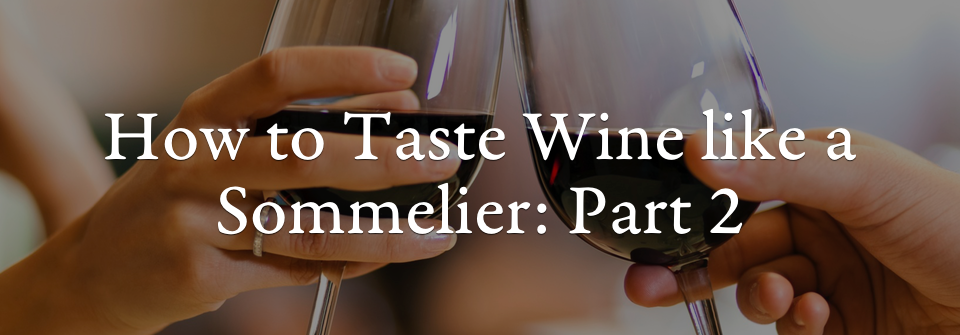
This is part 2 of a last week’s blog post. If you missed part 1, you can find it here.
As we discussed in Part 1 of this post, sommeliers use a grid-like system to assess wine. This allows them to use a number of key indicators in order to name a wine during a blind tasting. Here we’ll walk you through a tasting guide that we’ve designed for novice tasters to get a basic understanding of the process.
This first step in this entire process is to remember four letters: S N F S.
This stands for Sight, Nose, Flavor, and Structure. Personally, I remember this as “Some Noisey Flautists Smell.” I was both in band and orchestra in high school, so ‘smelly flautists’ work for me, but whatever helps you remember the steps is fine, so long as it’s an easy mnemonic device that allows me to remember the four steps to the deductive tasting process: Sight, Nose, Flavor, and Structure.
Here I’ll take you through each step of the Tasting Guide using the example of Poggio alla Guardia, an Italian red wine from Tuscany.

Sight
The first part of our tasting guide is in many ways the easiest, or at least the most self-explanatory: Sight. The sight section is broken into 6 different steps:
Clarity: As far as clarity of a wine is concerned, I ask myself if I can read through the wine when holding it over a page of text. In the case of Poggio alla Guardia the answer is no, but for many wines, especially white wines, you’ll have no problems making out words through the glass. Many wines will develop a slight haziness as they age. This is normal and a clue to the wines age.
Brightness: Brightness is a little bit tricky, and it’s best to have good light while determining it. Look at the way the overhead light reflects in the wine. That’s what you’re judging when you try to discern the brightness. For me, my wine is a very definite ‘dull.’
Color: On the Tasting Guide, there are lines for both red and white wines, but for my Italian red blend, only the red line is needed and it’s a decidedly garnet shade.
Rim variation: This concerns the change in color of the wine from the center of the glass to its outer edge. Some wines, especially older wines, will have a drastic change in color, but most young wines (maybe under 4 years old) will have very little if any change. Here, my wine is 2011 has no rim variation.
Staining: This measures the amount of red stain the wine leaves on the side of the glass. Once you’ve swirled your wine, you’ll notice a faint sheen on the glass. This only pertains to red wines. For my wine, I’ll mark “medium.”
Legs: Legs, sometimes called tears, are the way the wine slides down a glass after being swirled. Sometimes, you’ll notice that the wine begins to fall down the glass immediately, other times you’ll notice that will stay in place for several seconds before it falls. A general rule of thumb is that a wine with shorter legs (one that falls faster) will have either less alcohol and less sugar than a wine with longer legs. My glass today has medium legs.
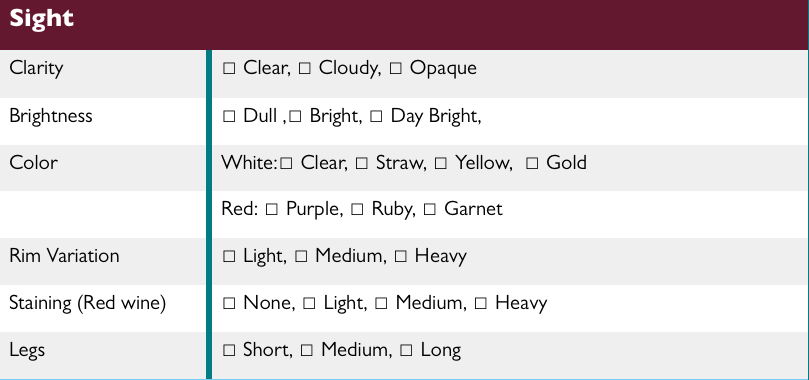
Nose
Here we smell the wine. Give it a good swirl and you’ll be ready to go!
Intensity: Right off the bat, as soon as I opened this bottle, I could smell and intense aroma of graphite, violets, and cherries. The farther you can smell a wine from your glass, the more intense it is.
Fruit: This is another field for which we have different lines for red and white wines. Red fruits, especially cherries and black cherries are dominating my glass. In a white wine, I would expect more apple and citrus aromas.
Fruit Character: The cherries here are abundant, but they definitely don’t smell fresh. I’d almost say they smelled just a little bit like the cherry jam I like on my toast in the mornings. Though the difference between under ripe and jammy fruit may seem small, when you smell or taste it in a wine, the difference become immediately noticeable.
Non-fruit Organics: Now this is always a tricky category – everyone’s palate is different and everyone picks up on something different. For my Italian red, I’m getting a very pronounced smell of violets (one of my favorite red wine smells!), and also a nice note of spiciness – some clove a white pepper.
Inorganics: This is where things always get really fun! Just like with our ‘non-fruit organics,’ different people can pick up on different things, and I always enjoy hearing different people’s take on the same wine. Right now, I’m getting a really heavy note of graphite (like a freshly sharpened pencil!)
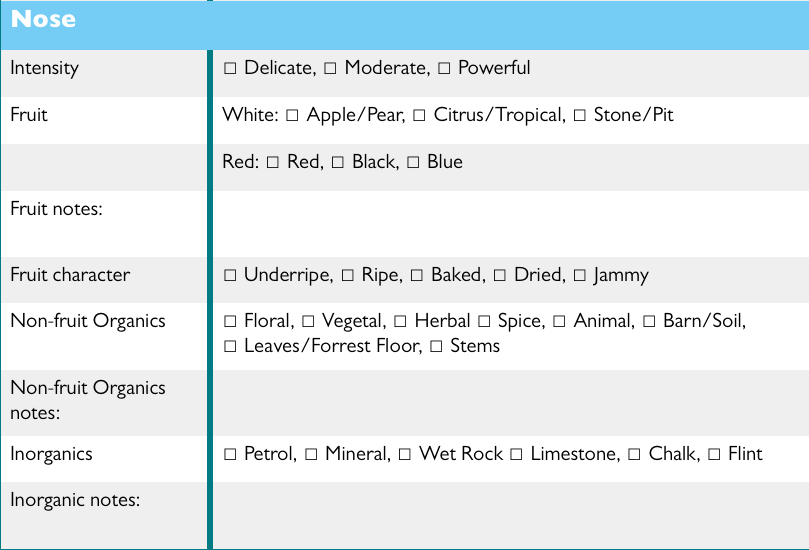
Flavor
You’re halfway through, and you finally get to taste your wine!
Fruit: Again, flavor is quite self-explanatory, it’s simply the flavors you find in the wine. On the palate I can taste, the black and red cherries are still there and they’re delicious!
Fruit character: Character describes the fruits we taste. Just like with the aroma, the cherries I’m tasting are quite jammy. Typically, wines with jammy fruit come from hot climates, and this wine came from scorching-hot Central Italy.
Non-fruit Organics: The violets I smelled earlier are really overwhelmed on the palate by notes of pepper, clove, and a really woodsy cedar note.
Inorganics: Like I said before, I’m getting a definite note of pencil shavings – it’s giving me a flashback to fourth grade!
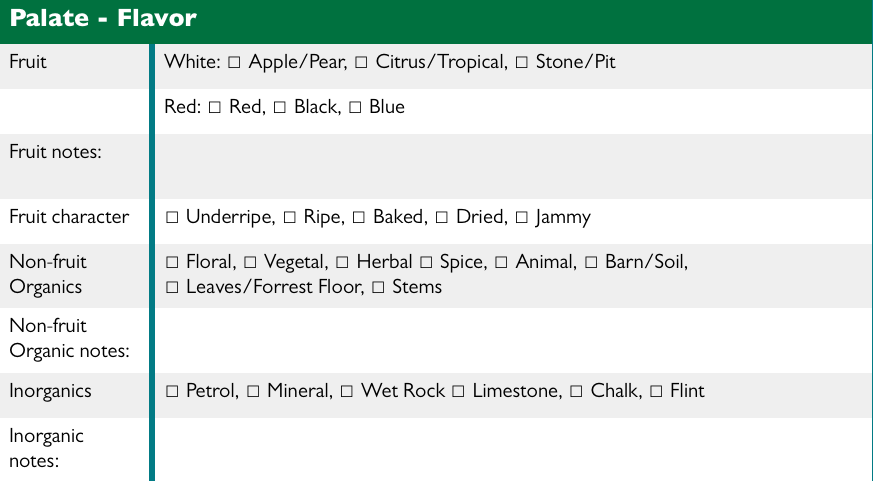
Structure
You’re in the home stretch!
Sweetness: Wines can be made to varying degrees of sweetness, though most of them tend to fall in the range of Bone Dry (no sugar at all), to Off Dry, which is a barely perceptible amount of sugar. My wine today is a totally dry wine.
Tannin: This is that hard-to-describe aspect of wine that sometimes comes off as bitterness. It’s also what can make your mouth pucker after taking a drink of a wine. I’m rating my wine as High. This is a blend of merlot, cabernet sauvignon, and sangiovese, three grapes with high tannins.
Acid: I tend to feel acid in the back of my mouth, in the part of my mouth that tends to clench itself when I’m tasting something sour. My wine has low acidity. Another way to test acidity is to take a sip and see if it makes your mouth water. High acid wines do this while low acid ones will leave your mouth a bit dry.
Alcohol: I can definitely feel the burn of alcohol when I swallow, which tells me this wine has high alcohol. I check the bottle and it’s confirmed: 14.5%.
Body: An easy way to think about the body of a wine is to compare it to milk. Is the wine I’m drinking closer to whole milk, 2% or skim? Obviously, a skim milk-like wine is lighter bodied than a fuller-bodied, whole milk-like wine. My wine is decidedly full-bodied.
Texture: Texture describes the way the liquid feels in your mouth. Some wines can feel very lean, almost like water, while others, especially those that have been aged in oak often take on a creamy character. My wine tonight doesn’t fit into either of those categories and instead gives off a nice round texture.
Balance: Balance is asking if all aspects of a wine, the nose and palate, work together. Are there any single notes that awkwardly stick out? For my wine, though the aroma and taste of cherries are both strong, they’re held in balance by the rest of the wine’s aromas and flavors.
Length/Finish: I like to think of this as the length it takes for any trace of the wine to disappear from my palate. This will vary depending upon the kind of wine you’re drinking, but my wine today has quite a long finish.
Complexity: Complexity is a catch-all term that describes the wine in its entirety with all its different parts averaged as a whole. A more complex wine will have a wide variety of aromas and flavors that work in tandem with the wine’s acidity and tannins to create a wine that’s vivid in the glass. If you have been filling out the guide you can look back and see how many descriptor you used. I can easily mark my wine tonight as “high.”
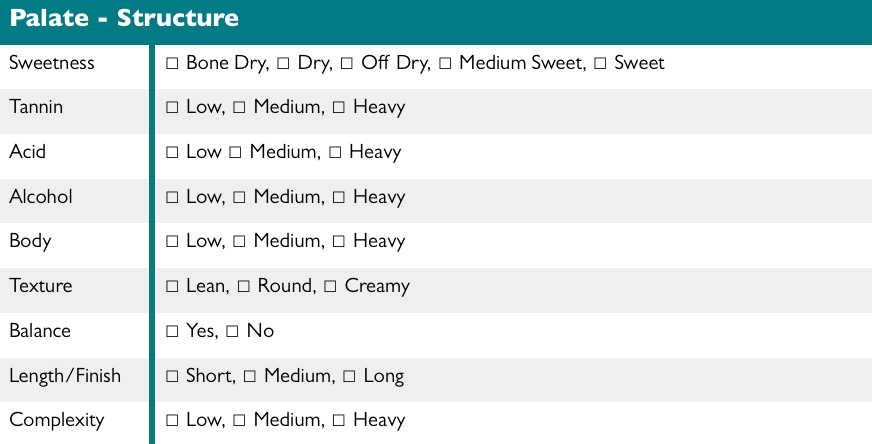
Our Tasting Guide is by no mean comprehensive, but it’s a perfect way to broaden your own knowledge base. You can download a printable PDF of our Tasting Guide by clicking the link below.
